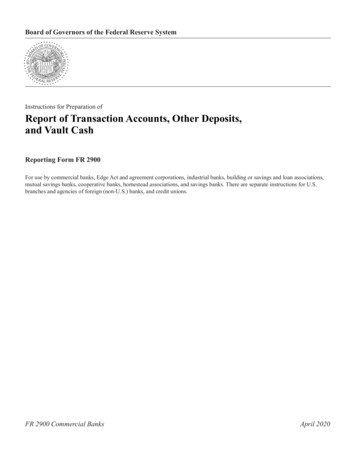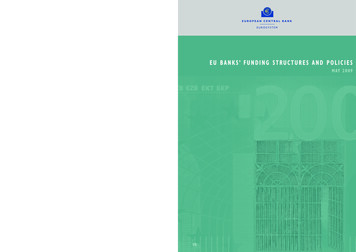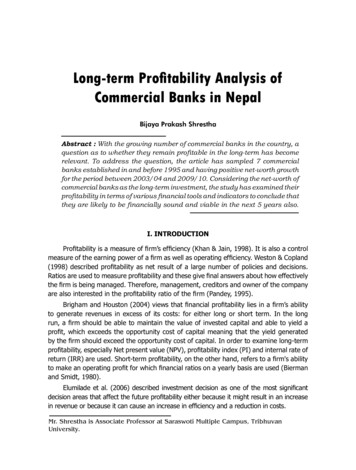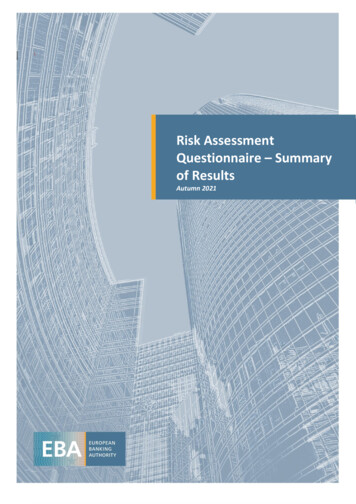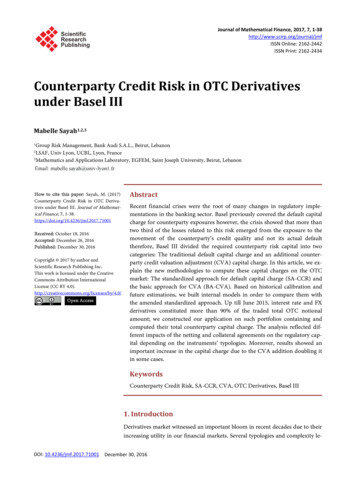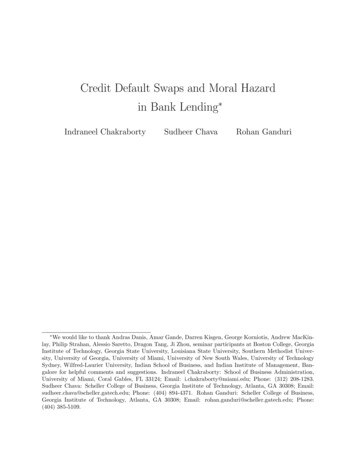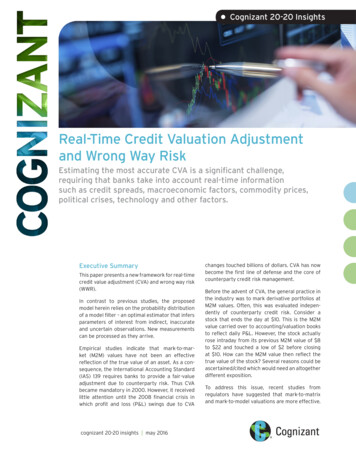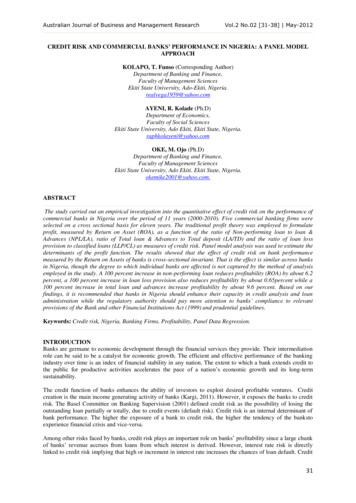
Transcription
Australian Journal of Business and Management ResearchVol.2 No.02 [31-38] May-2012CREDIT RISK AND COMMERCIAL BANKS’ PERFORMANCE IN NIGERIA: A PANEL MODELAPPROACHKOLAPO, T. Funso (Corresponding Author)Department of Banking and Finance,Faculty of Management SciencesEkiti State University, Ado-Ekiti, Nigeria.realvega1959@yahoo.comAYENI, R. Kolade (Ph.D)Department of Economics,Faculty of Social SciencesEkiti State University, Ado Ekiti, Ekiti State, Nigeria.raphkolayeni@yahoo.comOKE, M. Ojo (Ph.D)Department of Banking and Finance,Faculty of Management SciencesEkiti State University, Ado Ekiti. Ekiti State, Nigeria.okemike2001@yahoo.com.ABSTRACTThe study carried out an empirical investigation into the quantitative effect of credit risk on the performance ofcommercial banks in Nigeria over the period of 11 years (2000-2010). Five commercial banking firms wereselected on a cross sectional basis for eleven years. The traditional profit theory was employed to formulateprofit, measured by Return on Asset (ROA), as a function of the ratio of Non-performing loan to loan &Advances (NPL/LA), ratio of Total loan & Advances to Total deposit (LA/TD) and the ratio of loan lossprovision to classified loans (LLP/CL) as measures of credit risk. Panel model analysis was used to estimate thedeterminants of the profit function. The results showed that the effect of credit risk on bank performancemeasured by the Return on Assets of banks is cross-sectional invariant. That is the effect is similar across banksin Nigeria, though the degree to which individual banks are affected is not captured by the method of analysisemployed in the study. A 100 percent increase in non-performing loan reduces profitability (ROA) by about 6.2percent, a 100 percent increase in loan loss provision also reduces profitability by about 0.65percent while a100 percent increase in total loan and advances increase profitability by about 9.6 percent. Based on ourfindings, it is recommended that banks in Nigeria should enhance their capacity in credit analysis and loanadministration while the regulatory authority should pay more attention to banks’ compliance to relevantprovisions of the Bank and other Financial Institutions Act (1999) and prudential guidelines.Keywords: Credit risk, Nigeria, Banking Firms, Profitability, Panel Data Regression.INTRODUCTIONBanks are germane to economic development through the financial services they provide. Their intermediationrole can be said to be a catalyst for economic growth. The efficient and effective performance of the bankingindustry over time is an index of financial stability in any nation. The extent to which a bank extends credit tothe public for productive activities accelerates the pace of a nation’s economic growth and its long-termsustainability.The credit function of banks enhances the ability of investors to exploit desired profitable ventures. Creditcreation is the main income generating activity of banks (Kargi, 2011). However, it exposes the banks to creditrisk. The Basel Committee on Banking Supervision (2001) defined credit risk as the possibility of losing theoutstanding loan partially or totally, due to credit events (default risk). Credit risk is an internal determinant ofbank performance. The higher the exposure of a bank to credit risk, the higher the tendency of the bankstoexperience financial crisis and vice-versa.Among other risks faced by banks, credit risk plays an important role on banks’ profitability since a large chunkof banks’ revenue accrues from loans from which interest is derived. However, interest rate risk is directlylinked to credit risk implying that high or increment in interest rate increases the chances of loan default. Credit31
Australian Journal of Business and Management ResearchVol.2 No.02 [31-38] May-2012risk and interest rate risk are intrinsically related to each other and not separable (Drehman, Sorensen, andStringa, 2008).Increasing amount of non-performing loans in the credit portfolio is inimical to banks inachieving their objectives. Non-performing loan is the percentage of loan values that are not serviced for threemonths and above (Ahmad and Ariff, 2007).Due to the increasing spate of non-performing loans, the Basel II Accord emphasized on credit risk managementpractices. Compliance with the Accord means a sound approach to tackling credit risk has been taken and thisultimately improves bank performance. Through the effective management of credit risk exposure, banks notonly support the viability and profitability of their own business, they also contribute to systemic stability and toan efficient allocation of capital in the economy (Psillaki, Tsolas, and Margaritis, 2010).The Nigerian banking industry has been strained by the deteriorating quality of its credit assets as a result of thesignificant dip in equity market indices, global oil prices and sudden depreciation of the naira against globalcurrencies (BGL Banking Report, 2010).The poor quality of the banks’ loan assets hindered banks to extendmore credit to the domestic economy, thereby adversely affecting economic performance. This prompted theFederal Government of Nigeria through the instrumentality of an Act of the National Assembly to establish theAsset Management Corporation of Nigeria (AMCON) in July, 2010 to provide a lasting solution to the recurringproblems of non-performing loans that bedeviled Nigerian banks. According to Ahmad and Ariff (2007), mostbanks in economies such as Thailand, Indonesia, Malaysia, Japan and Mexico experienced high non-performingloans and significant increase in credit risk during financial and banking crises, which resulted in the closingdown of several banks in Indonesia and Thailand.The aim of this paper is to assess the impact of credit risk on the performance of Nigerian banks over a period ofeleven years (2000-2010). The study is motivated by the damaging effect of classified assets on bankcapitalization and would be of utmost relevance as it addresses how credit risk affects banks’ profitability usinga robust sample and the findings would serve as the basis to provide policy measures to the various stakeholderson how to tackle the effect of credit risk in order to enhance the quality of banks’ risk assets.A total of twenty commercial banks operate presently in Nigeria, out of which cluster sample of five was drawn.The banks in no particular order include First Bank Plc., United Bank for Africa Plc., Guaranty Trust Bank Plc.,Zenith Bank Plc., andAccess Bank Plc. The basis for the selection rests on the fact that these banks have beenrated as the topmost five Nigerian banks by Fitch rating and Bankers’ magazine as at January 2012 and theyaccount for over fifty percent of deposit liabilities in the Nigerian banking sector. The remainder of the paper isoutlined as follows- Section two reviews related literature on the subject matter, section three discusses themethodology, section four focuses on data analysis and interpretation of findings and section five presents theconclusion and recommendations.LITERATURE REVIEWA bank exists not only to accept deposits but also to grant credit facilities, therefore inevitably exposed to creditrisk. Credit risk is by far the most significant risk faced by banks and the success of their business depends onaccurate measurement and efficient management of this risk to a greater extent than any other risks (Gieseche,2004). According to Chen and Pan (2012), credit risk is the degree of value fluctuations in debt instruments andderivatives due to changes in the underlying credit quality of borrowers and counterparties. Coyle (2000)defines credit risk as losses from the refusal or inability of credit customers to pay what is owed in full and ontime. Credit risk is the exposure faced by banks when a borrower (customer) defaults in honouring debtobligations on due date or at maturity. This risk interchangeably called ‘counterparty risk’ is capable of puttingthe bank in distress if not adequately managed. Credit risk management maximizes bank’s risk adjusted rate ofreturn by maintaining credit risk exposure within acceptable limit in order to provide framework forunderstanding the impact of credit risk management on banks’ profitability (Kargi, 2011). Demirguc-Kunt andHuzinga (1999) opined that credit risk management is in two-fold which includes, the realization that afterlosses have occurred, the losses becomes unbearable and the developments in the field of financing commercialpaper, securitization, and other non-bank competition which pushed banks to find viable loan borrowers.The main source of credit risk include, limited institutional capacity, inappropriate credit policies, volatileinterest rates, poor management, inappropriate laws, low capital and liquidity levels, direct lending, massivelicensing of banks, poor loan underwriting, laxity in credit assessment, poor lending practices, governmentinterference and inadequate supervision by the central bank (Kithinji, 2010).An increase in bank credit riskgradually leads to liquidity and solvency problems. Credit risk may increase if the bank lends to borrowers itdoes not have adequate knowledge about.\32
Australian Journal of Business and Management ResearchVol.2 No.02 [31-38] May-2012CREDIT RISK MANAGEMENT STRATEGIESThe credit risk management strategies are measures employed by banks to avoid or minimize the adverse effectof credit risk. A sound credit risk management framework is crucial for banks so as to enhance profitabilityguarantee survival. According to Lindergren (1987), the key principles in credit risk management process aresequenced as follows; establishment of a clear structure, allocation of responsibility, processes have to beprioritized and disciplined, responsibilities should be clearly communicated and accountability assigned. Thestrategies for hedging credit risk include but not limited to these;i. Credit Derivatives: This provides banks with an approach which does not require them to adjust their loanportfolio. Credit derivatives provide banks with a new source of fee income and offer banks the opportunityto reduce their regulatory capital (Shao and Yeager, 2007). The commonest type of credit derivative iscredit default swap whereby a seller agrees to shift the credit risk of a loan to the protection buyer. FrankPartnoy and David Skeel in Financial Times of 17 July, 2006 said that “credit derivatives encourage banksto lend more than they would, at lower rates, to riskier borrowers”. Recent innovations in credit derivativesmarkets have improved lenders’ abilities to transfer credit risk to other institutions while maintainingrelationship with borrowers (Marsh, 2008).ii. Credit Securitization: It is the transfer of credit risk to a factor or insurance firm and this relieves the bankfrom monitoring the borrower and fear of the hazardous effect of classified assets. This approach insuresthe lending activity of banks. The growing popularity of credit risk securitization can be put down to thefact that banks typically use the instrument of securitization to diversify concentrated credit risk exposuresand to explore an alternative source of funding by realizing regulatory arbitrage and liquidityimprovements when selling securitization transactions (Michalak and Uhde,2009). A cash collateralizedloan obligation is a form of securitization in which assets (bank loans) are removed from a bank’s balancesheet and packaged (tranched) into marketable securities that are sold on to investors via a special purposevehicle (SPV) (Marsh,2008).iii. Compliance to Basel Accord: The Basel Accord are international principles and regulations guiding theoperations of banks to ensure soundness and stability. The Accord was introduced in 1988 in Switzerland.Compliance with the Accord means being able to identify, generate, track and report on risk-related data inan integrated manner, with full auditability and transparency and creates the opportunity to improve the riskmanagement processes of banks. The New Basel Capital Accord places explicitly the onus on banks toadopt sound internal credit risk management practices to assess their capital adequacy requirements (Chenand Pan,2012).iv. Adoption of a sound internal lending policy: The lending policy guides banks in disbursing loans tocustomers. Strict adherence to the lending policy is by far the cheapest and easiest method of credit riskmanagement. The lending policy should be in line with the overall bank strategy and the factors consideredin designing a lending policy should include; the existing credit policy, industry norms, general economicconditions of the country and the prevailing economic climate (Kithinji,2010).v. Credit Bureau: This is an institution which compiles information and sells this information to banks asregards the lending profile of a borrower. The bureau awards credit score called statistical odd to theborrower which makes it easy for banks to make instantaneous lending decision. Example of a credit bureauis the Credit Risk Management System (CRMS) of the Central Bank of Nigeria (CBN).REVIEW OF RELATED EMPIRICAL LITERATURECredit risk is a serious threat to the performance of banks; therefore various researchers have examined theimpact of credit risk on banks in varying dimensions.Kargi (2011) evaluated the impact of credit risk on the profitability of Nigerian banks. Financial ratios asmeasures of bank performance and credit risk were collected from the annual reports and accounts of sampledbanks from 2004-2008 and analyzed using descriptive, correlation and regression techniques. The findingsrevealed that credit risk management has a significant impact on the profitability of Nigerian banks. It concludedthat banks’ profitability is inversely influenced by the levels of loans and advances, non-performing loans anddeposits thereby exposing them to great risk of illiquidity and distress. Epure and Lafuente (2012) examinedbank performance in the presence of risk for Costa-Rican banking industry during 1998-2007. The resultsshowed that performance improvements follow regulatory changes and that risk explains differences in banksand non-performing loans negatively affect efficiency and return on assets while the capital adequacy ratio has apositive impact on the net interest margin.Kithinji (2010) assessed the effect of credit risk management on the profitability of commercial banks in Kenya.Data on the amount of credit, level of non-performing loans and profits were collected for the period 2004 to2008. The findings revealed that the bulk of the profits of commercial banks are not influenced by the amount ofcredit and non-performing loans, therefore suggesting that other variables other than credit and non-performing33
Australian Journal of Business and Management ResearchVol.2 No.02 [31-38] May-2012loans impact on profits. Chen and Pan (2012) examined the credit risk efficiency of 34 Taiwanese commercialbanks over the period 2005-2008. Their study used financial ratio to assess the credit risk and was analyzedusing Data Envelopment Analysis (DEA). The credit risk parameters were credit risk technical efficiency (CRTE), credit risk allocative efficiency (CR-AE), and credit risk cost efficiency (CR-CE). The results indicatedthat only one bank is efficient in all types of efficiencies over the evaluated periods. Overall, the DEA resultsshow relatively low average efficiency levels in CR-TE, CR-AE and CR-CE in 2008.Felix and Claudine (2008) investigated the relationship between bank performance and credit risk management.It could be inferred from their findings that return on equity (ROE) and return on assets (ROA) both measuringprofitability were inversely related to the ratio of non-performing loan to total loan of financial institutionsthereby leading to a decline in profitability. Ahmad and Ariff (2007) examined the key determinants of creditrisk of commercial banks on emerging economy banking systems compared with the developed economies. Thestudy found that regulation is important for banking systems that offer multi-products and services; managementquality is critical in the cases of loan-dominant banks in emerging economies. An increase in loan loss provisionis also considered to be a significant determinant of potential credit risk. The study further highlighted thatcredit risk in emerging economy banks is higher than that in developed economies.Al-Khouri (2011) assessed the impact of bank’s specific risk characteristics, and the overall bankingenvironment on the performance of 43 commercial banks operating in 6 of the Gulf Cooperation Council (GCC)countries over the period 1998-2008. Using fixed effect regression analysis, results showed that credit risk,liquidity risk and capital risk are the major factors that affect bank performance when profitability is measuredby return on assets while the only risk that affects profitability when measured by return on equity is liquidityrisk. Ben-Naceur and Omran (2008) in attempt to examine the influence of bank regulations, concentration,financial and institutional development on commercial banks’ margin and profitability in Middle East and NorthAfrica (MENA) countries from 1989-2005 found that bank capitalization and credit risk have positive andsignificant impact on banks’ net interest margin, cost efficiency and profitability.Ahmed, Takeda and Shawn (1998) in their study found that loan loss provision has a significant positiveinfluence on non-performing loans. Therefore, an increase in loan loss provision indicates an increase in creditrisk and deterioration in the quality of loans consequently affecting bank performance adversely.METHODOLOGYThe bane of the study is to empirically examine the quantitative effect of credit risk on the performance of banksin Nigeria over the period of 11 years (2000-2010). As earlier stated in section one, 5 banks were chosen fromthe twenty existing commercial banks. The banks are First bank of Nigeria Plc., United Bank for Africa Plc.,Guaranty Trust Bank Plc., Zenith Bank Plc., and Access Bank Plc. Data were sourced from the Annual Reportsand Accounts of the banks in the sample. The data include time-series and cross-sectional data, therefore pooledinto a panel data set and estimated using Panel Data regression.The justification for banks in the sample include; The five banks have being rated the topmost five banks in Nigeria by the Fitch rating and The Banker’smagazine of July, 2012 (A publication of Financial Times). These banks have also made the list of the first25 and 500 banks in Africa and the world respectively. The banks under review have been largely homogenous to the extent that their ownership structures aresignificantly unaffected by the spate of mergers and acquisitions that characterized the revolution incommercial banking in Nigeria since 2004 and 2011. The five banks relatively account for over fifty percent of the total deposit liability in the industry. As atDecember 2011, the total deposit in the industry was about N10.99 trillion, out of which the five selectedbanks accounted for N6.17 trillion, representing 56.13% of the total deposit. In terms of credit score ratings, the banks have moved from stability to the positive credit rating as of theJanuary 2012 rating (Fitch, Standard and Poors, and Agusto and Co.). The banks have a large customer base and are active players on the Nigerian Stock Exchange (NSE).SPECIFICATION OF THE MODELThe model adopted for this study is underpinned to the model of Kargi (2011) in his study “Credit Risk and thePerformance of Nigerian Banks” which measured profitability with Return on Asset (ROA) as a function of theratio of Non-performing loan to loan & Advances (NPL/LA) and ratio of Total loan & Advances to Totaldeposit (LA/TD) used as indicators of credit risk. However, the study improved on the model by incorporatingthe ratio of loan loss provision to classified assets (LLP/CL) as a measure for credit risk.34
Australian Journal of Business and Management ResearchVol.2 No.02 [31-38] May-2012The model for this study functionally becomes;ROA f (NPL/LA, LLP/CL, LA/TD) . (1)Where;ROA:Return on AssetsNPL:Non-Performing LoanLA:Loan and AdvancesLLP:Loan loss provisionCL:Classified LoanTD:Total DepositThe econometric equation for the model is specified asROA 0 1NPLLLPLA 2 3 .(2)LACLTDWhere;β0 Constant parameter/Interceptβ1-β3 Coefficients of independent variablesµ Error termThe ‘a priori expectation’ in the model is that all the independent variables are expected to have a negativerelationship on bank performance measured by Return on Assets (ROA) except loans and advances which isexpected to have a positive relationship with bank performance. The mathematical expression is represented as;β1, β2, 0 and β3 0 implying that a unit increase in the independent variables will lead to decrease in ROA by aunitThe model in equation 2 can be rewritten as follows:ROA 0 1 NPL * 2 LLP * 3 LA * .(3)WhereNPLLALLPLLP* CLNPL* LA* LATDThe study uses panel data regression model in the analysis. The technique of panel data estimation takes care ofthe problem of heterogeneity in the 5 Banks selected for the study. Also, by combining time series of crosssection observation, panel data give more informative data, more variability, less co-linearity among thevariables, more degree of freedom and more efficiency (Gujarati and Sangeetha, 2007).EMPIRICAL RESULTSResult of the Constant Effect Model:The major assumption under this model is that all coefficients are constant across time period and individualbank. By interpretation, following the objective of this study, the assumption can be summarized as follows:1. The period time used by this study (2000-2010) is the period when the global economy witnessed adownward trend in business cycle from recession to depression, popularly called “economic melt-down”.The constant Effect Model thus assumes that all the coefficients in this model remain unchanged acrossbanks during this period of time2. The time (melt-down) effect is also constant. That is, all the determinants of Bank performance used in ourmodel (NPL, LLP, LA) are not affected by economic melt-down.35
Australian Journal of Business and Management ResearchVol.2 No.02 [31-38] May-2012The OLS results of the model are given belowTable 1: Constant Effect Model Estimates.VariablesCoefficientStandard 40-1.7697Probability0.00000.00000.00000.082R 2 0.76, D.W 2.87, N 55, Prob.(F) 0.000Source : Authors’ ComputationAn examination of the results of the panel data in Table 1 shows that all the coefficient are individuallystatistically significant at both 1% and 5% level of significance and all the slope coefficients have expectednegative signs.The R 2 is considerably high (0.76), and significant. The estimated Durbin Watson statistics isrelatively high, suggesting that there is no problem of autocorrelation in the data.The intercept value is negative (not significant). By assumption the intercept value is the same for all the 5banks. Also, the slope coefficients of the three variables are assumed to be identical for all five banks.Obviously, these are highly restricted assumptions.This result obviously distorts the true picture of the relationship between bank performance and all theindependent variables across the five banks. Even though the R 2 suggests that 78 percent of the total variationin return on asset across the banking firms is explained by joint variations in the five variables, the influence oftime variations by business cycle (economic melt-down) is totally omitted by the Constant Effect Model.1. Result Of The Fixed Effect Model (FEM) – Cross Sectional SpecificOne way to take into account the individuality of each company is to let the intercept vary for each company butstill assume that the slope coefficients are constant across firms. The term “Fixed Effect “is due to the fact thatalthough the intercept may differ across individuals (that is, the five banks), each individual’s intercept does notvary over time. That is, it is time invariant. This is the major assumption under this model. That is, while theintercept are cross-sectional variant, they are time invariant. The result of the Fixed Effect Model under thisassumption is presented in Table 2.Table 2: Fixed Effect (Cross Sectional Specific) EstimatesVariableCoefficientsStandard 0000R 2 0.78 D.W 2.87, Prob (F) 0.0000, N 55Source : Authors’ ComputationCompare this regression result with Table 1. In Table 2, Coefficients of NPL, LLP, and LA are highlysignificant as the probability values of the estimated “t” coefficient are extremely small. The intercept values ofthe five banks are statistically the same as shown below.FBN UBA GTB ZNT ACS 6.11E-18This attribute in the intercepts may be due to the unique features of the banking industry in Nigeria, such asoperating under the same control and policy of the Central Bank of Nigeria. To test whether the effect of creditrisk on bank performance across banks in Nigeria is cross-sectional variant, we use the restricted F test.F 0.78 0.76 / 3 1.675 1 0.78 / 55Critical value of F at 3, 55 df 2.7636
Australian Journal of Business and Management ResearchVol.2 No.02 [31-38] May-2012Clearly the F value of 1.675 (for 3 numerator degree of freedom and 55 denominator degree of freedom) is notsignificant and we therefore conclude that the restricted regressions of Table 1 Seems to be valid. The effect ofcredit risk on bank performance measured by the Return on Assets of banks is cross-sectional invariant i.e. it issimilar across banks in Nigeria.The three exogenous variables in Table 2 are ratio of Non-performing loan to loan & Advances (NPL/LA), ratioof Total loan & Advances to Total deposit (LA/TD) and ratio of loan loss provision to classified assets(LLP/CL) used as indicators of credit risk.From table 2, a 100% increase in non-performing loan reduces profitability (ROA) by about 6.2%; a 100%increase in loan loss provision also reduces profitability by about 0.65% while a 100% increase in total loan andadvances increase profitability by about 9.6%. This should be expected as loans and advances generate interestfor banks.CONCLUSION AND RECOMMENDATIONSThe following conclusions are made from the panel data regression analysis of the effect of credit risk on bankperformance measured by return on equity.The effect of credit risk on bank performance measured by the Return on Assets of banks is cross-sectionalinvariant. That is, nature and managerial pattern of individual firms do not determine the impact. This isrevealed by the restricted F – test under the fixed effect analysis.Loan and Advances ratio (LA) coefficient exerts most significant positive effect on the profitability across thebanking firms.Based on our findings, it is recommended that banks in Nigeria should enhance their capacity in credit analysisand loan administration while the regulatory authority should pay more attention to banks’ compliance torelevant provisions of the Bank and other Financial Institutions Act (1999) and prudential guidelines.REFERENCES1. Agusto and Co., 5th Floor, UBA House, Lagos (accessed from www.agusto.com)2. Ahmad, N.H. and Ariff, M. (2007).Multi-country Study of Bank Credit Risk Determinants, InternationalJournal of Banking and Finance, 5(1), 135-152.3. Ahmed, A.S., Takeda, C. and Shawn, T. (1998). Bank Loan Loss Provision: A Reexamination of CapitalManagement and Signaling Effects, Working Paper, Department of Accounting, Syracuse University, 1-37.4. Al-Khouri, R. (2011). Assessing the Risk and Performance of the GCC BankingSector, InternationalJournal of Finance and Economics, ISSN 1450-2887,Issue65, 72-8.5. Basel Committee on Banking Supervision (2001). Risk Management Practices and Regulatory Capital:Cross-Sectional Comparison (available at www.bis.org)6. Ben-Naceur, S. and Omran, M. (2008). The Effects of Bank Regulations, Competition and FinancialReforms on MENA Banks’ Profitability, Economic Research Forum Working Paper No. 44.7. BGL Banking Report (2010). Getting Banks to Lend Again The Banker’s Magazine of July 2012,publication of The Financial Times Ltd., London.8. Chen, K. and Pan, C. (2012). An Empirical Study of Credit Risk Efficiency of Banking Industry in Taiwan,Web Journal of Chinese Management Review, 15(1), 1-16.9. Coyle, B. (2000). Framework for Credit Risk Management, Chartered Institute ofBankers,UnitedKingdom10. Demirguc-Kunt, A. and Huzinga, H. (1999). Determinants of Commercial Bank Interest Margins andProfitability: Some International Evidence, The World Bank Economic Review, 13(2), 379-40.11. Drehman, M., Sorensen, S. & Stringa, M. (2008). The Integrated Impact of Credit and Interest Rate Risk onBanks: An Economic Value and Capital AdequacyPerspective”, Bank of England Working PaperNo.33912. Epure, M. and Lafuente, I. (2012). Monitoring Bank Performance in the Presence of Risk, Barcelona GSEWorking Paper Series No.61.13. Felix, A.T and Claudine, T.N (2008). Bank Performance and Credit Risk Management,UnpublishedMasters Dissertation in Finance, University of Skovde.14. Fitch Rating, a subsidiary of Fitch Group, London and New York (accessed from www.fitchratings.com).15. Gieseche, K. (2004). “Credit Risk Modelling and Valuation: An Introduction”, Credit Risk: Models andManagement, Vol.2, Cornell University, London.16. Gujarati, D.N. and Sangeetha, S. (2007). Basic Econometric, 4th Edition, McGraw-Hill Education BooksL
The credit risk management strategies are measures employed by banks to avoid or minimize the adverse effect of credit risk. A sound credit risk management framework is crucial for banks so as to enhance profitability guarantee survival. According to Lindergren (1987), the key principles in credit risk management process are .

